
Western Airlines was a major airline in the United States based in California, operating in the Western United States including Alaska and Hawaii, and western Canada, as well as to New York City, Boston, Washington, D.C., and Miami and to Mexico City, London and Nassau. Western had hubs at Los Angeles International Airport, Salt Lake City International Airport, and the former Stapleton International Airport in Denver. Before it merged with Delta Air Lines in 1987 it was headquartered at Los Angeles International Airport (LAX). Throughout the company's history, its slogan was "Western Airlines...The Only Way to Fly!"

Trans World Airlines (TWA) was a major airline in the United States that operated from 1930 until it was acquired by American Airlines in 2001. It was formed as Transcontinental & Western Air to operate a route from New York City to Los Angeles via St. Louis, Kansas City, and other stops, with Ford Trimotors. With American, United, and Eastern, it was one of the "Big Four" domestic airlines in the United States formed by the Spoils Conference of 1930.

El Paso International Airport is an international airport located four miles (6 km) northeast of downtown El Paso, in El Paso County, Texas, United States. It is the busiest commercial airport in West Texas, and also serves Southern New Mexico and Northern Mexico. It handled 3,904,110 passengers in 2023, with 96,316 aircraft operations.

Albuquerque International Sunport, locally known as the Sunport, is the primary international airport serving the U.S. state of New Mexico, particularly the Albuquerque metropolitan area and the larger Albuquerque–Santa Fe–Los Alamos combined statistical area. It handles around 5.4 million passengers annually and over 400 flights daily. ABQ is located in Bernalillo County, between the Rio Grande and the Sandia Mountains, east of Old Town and Barelas, 3 miles (5 km) southeast of downtown, south of the University of New Mexico and directly to the west of Sandia National Laboratories and Kirtland Air Force Base.

The Lockheed Constellation ("Connie") is a propeller-driven, four-engined airliner built by Lockheed Corporation starting in 1943. The Constellation series was the first civil airliner family to enter widespread use equipped with a pressurized cabin, enabling it to fly well above most bad weather, thus significantly improving the general safety and ease of commercial passenger air travel.
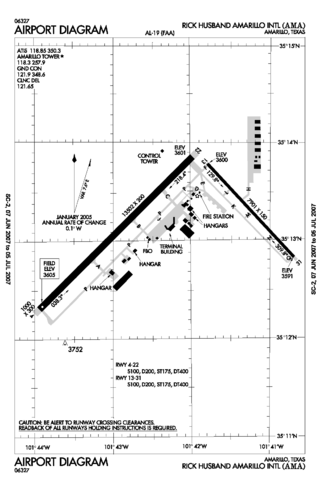
Rick Husband Amarillo International Airport is a public airport six miles (10 km) east of downtown Amarillo, in Potter County, Texas, United States. The airport was renamed in 2003 after NASA astronaut and Amarillo native Rick Husband, who died in the Space Shuttle Columbia disaster in February of that year.
Lethbridge Airport, previously Lethbridge County Airport, is located 4 nautical miles south-southeast of Lethbridge, Alberta, Canada. It is 10–15 driving minutes from downtown Lethbridge, and has scheduled service to the city of Calgary, Alberta. The airport is classified as an airport of entry by Nav Canada and is staffed by the Canada Border Services Agency (CBSA) on a call-out basis from the Sweetgrass-Coutts Border Crossing. CBSA officers at this airport can handle general aviation aircraft only, with no more than 15 passengers. The airport was the site of the biennial Lethbridge International Airshow until 2023.
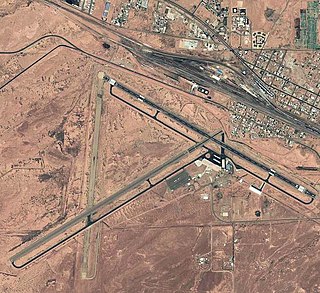
Winslow–Lindbergh Regional Airport is 1 mile mile west of Winslow, in Navajo County, Arizona. The U.S. Forest Service has a firefighting air tanker base here. The airport was served by TWA and Frontier Airlines but now sees no airline service.

The Fokker F.VII, also known as the Fokker Trimotor, was an airliner produced in the 1920s by the Dutch aircraft manufacturer Fokker, Fokker's American subsidiary Atlantic Aircraft Corporation, and several other companies under license. It was an airliner that could carry 6-12 people, depending on the version, and it used a variety of engines; early versions had one engine but three was more common.

West Mesa Airport, also known as Western Air Express Airport, TWA Airport, or Cutter-Carr Airport, was an airport on the West Side of Albuquerque, New Mexico, United States, which was the city's main commercial aviation facility during the 1930s. It was built in 1929 by Western Air Express as a stop on the airline's Los Angeles–Kansas City route, with a hangar and passenger terminal added in 1930. It was the city's second airfield after the original Albuquerque Airport, which was used by a rival airline, Transcontinental Air Transport (TAT). The two airlines merged in 1930 to form TWA, moving all of their operations to the West Mesa field. The merger gave TWA control of the nation's first coast-to-coast passenger airline route and allowed it to secure a lucrative federal airmail contract.
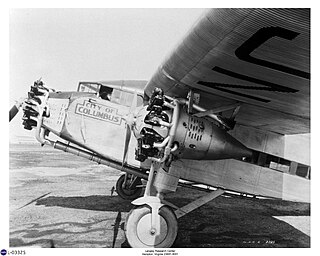
Transcontinental Air Transport (T-A-T) was an airline founded in 1928 by Clement Melville Keys that merged in 1930 with Western Air Express to form what became TWA. Keys enlisted the help of Charles Lindbergh to design a transcontinental network to get government airmail contracts. Lindbergh established numerous airports across the country in this effort.
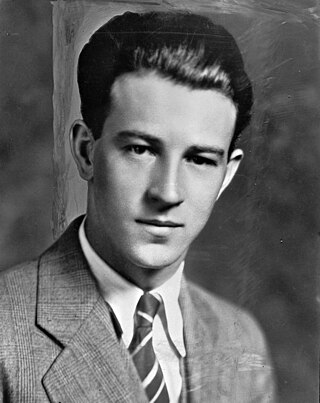
William John "Jack" Frye was an American aviation pioneer in the airline industry. He founded Standard Air Lines which eventually took him into a merger with Trans World Airlines (TWA). He is credited for turning TWA into a world-class airline during his tenure as president from 1934 to 1947. Frye was called "The Flying President" among his peers. At age 24, he was and to this day remains the youngest airline executive of all time.

Bonanza Air Lines was a local service carrier, a US scheduled airline focused on smaller routes in the Western United States from 1949 until it merged with two other local service airlines to form Air West in 1968. Its headquarters was initially Las Vegas, Nevada, and moved to Phoenix, Arizona in 1966.

Maddux Air Lines was an airline based in Southern California that operated Ford Tri-motors in California, Arizona, and Mexico in the late 1920s.

On March 31, 1931, a Fokker F-10 belonging to Transcontinental and Western Air crashed near Bazaar, Kansas after taking off from Kansas City Municipal Airport, Kansas City, Missouri.
A transcontinental flight is a non-stop passenger flight from one side of a continent to the other. The term usually refers to flights across the United States, between the East and West Coasts.
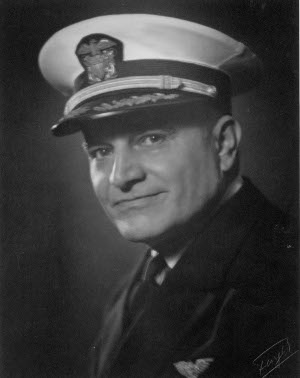
Paul Ernest Richter Jr. was an American aviation pioneer, co-founder of Standard Air Lines and executive vice president of Trans World Airlines (TWA), operations chief of staff of the Naval Air Transport Service during World War II and chairman of the board, president of TACA Airlines from 1947 to 1949.

The Fokker F-10 was an enlarged development of the Fokker F.VII airliner, built in the late 1920s by the Fokker Aircraft Corporation of America. It was a trimotor passenger aircraft, and it carried 12 passengers. This was four more than the F.VII it was based on, and it had a larger wing and more powerful engines than that design. A crash of this aircraft in 1931, lead to widespread reforms in the U.S. aviation industry and hurt the reputation of wooden winged' aircraft, especially the Fokker Tri-motor types.
Standard Air Lines was an airline founded by Jack Frye, Paul E. Richter and Walter A. Hamilton in 1927. The three had founded Aero Corporation of California in 1926 in Los Angeles and Standard was made a subsidiary of Aero in 1927.















